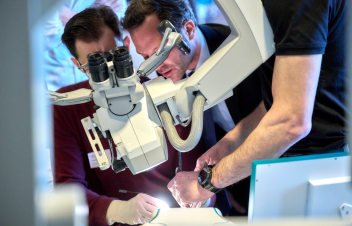How Are Neuro Interventional Models Revolutionizing Stroke Treatment?
- surgeonslab1
- Apr 11
- 4 min read

Stroke is still one of the biggest causes of disability and death globally. Advances in neurointerventional models have changed how doctors treat acute ischemic stroke in recent years. Leading minimally invasive stroke treatment models span endovascular devices, high-fidelity simulators, and real-time imaging tools. Neurointerventional models are enhancing clinical results and changing how interventional professionals learn and gain skills. This is done by blending new technologies with strong training.
Advancements in Neuro-Interventional Models
Modern neurointerventional methods use advanced technology. This includes artificial intelligence (AI), robots, and high-tech imaging. AI image processing quickly analyzes CT and MRI scans. It helps doctors find the location and severity of a stroke right away. This analysis speeds up decision-making during mechanical thrombectomy. In this treatment, stent retrievers or aspiration devices remove blood clots blocking brain veins. AI lowers human error and boosts the chances of restoring blood flow in the crucial golden hour.
Robotic systems are a big step forward. They offer better dexterity and stability during complex procedures. These robotic instruments can navigate microcatheters with exceptional accuracy via intricate circulatory systems. Neurointerventional models use real-time feedback and motion control. This improves precision during procedures and reduces risks like vascular damage.
High-Fidelity Simulation for Training and Practice
The swift advancements in neuro-interventional devices necessitate correspondingly advanced training methodologies. Simulation-based teaching has become essential in equipping interventionalists for high-pressure clinical situations. High-fidelity simulators create a safe space for doctors. They can practice procedures often, improve their skills, and build confidence.
For example, sophisticated simulators duplicate authentic vascular anatomies and emulate patient-specific circumstances. These simulations let users practice interventions safely. They can work on catheter navigation, guidewire manipulation, and complex procedures like thrombectomy and stenting.
Enhancing Stroke Treatment with Neuro-Interventional Models
Time is brain—a principle that emphasizes the urgency of any stroke intervention. Neurointerventional models have transformed the discipline by markedly decreasing the door-to-treatment interval. Better imaging in these models allows doctors to evaluate the ischemic penumbra quickly and locate viable tissue compared to past models. This exact location makes directed thrombectomy possible. It quickly removes the clot and restores blood flow, therefore averting major injury.
AI-driven decision support systems tailor treatments to each patient's anatomy and health. This approach improves therapy safety and long-term results. Neurointerventional models enhance accuracy, lessening operation risks and complications. Thus, stroke patients recover better.
Impact on Clinical Outcomes and Cost-Effectiveness
Neuro interventional models provide swift and precise clot retrieval, mitigating brain damage severity post-stroke. Research indicates that prompt mechanical thrombectomy enhances functional independence rates and reduces mortality rates.
Besides medicinal advantages, these innovations possess considerable economic ramifications. Enhanced outcomes result in abbreviated hospitalizations, diminished necessity for prolonged rehabilitation, and decreased overall healthcare expenditures. As hospitals and healthcare systems use these novel methods, the cost-effectiveness of stroke care increasingly improves.
The Role of Simulation in Transforming Stroke Intervention Training
Simulation-based platforms are indispensable in closing the knowledge gap between theory and actual application. These systems let neurosurgeons and interventional radiologists practice real neurointerventions hands-on. Trainees can practice advanced treatments using detailed human vascular anatomy and specific physiological conditions. These include catheter-based thrombectomy, aneurysm coiling, and flow diversion procedures.
SurgeonsLab's innovative simulator models provide an immersive experience. They blend virtual reality with physical realism. The simulators copy patient-specific situations so that practitioners may practice interventions in a controlled setting and create pre-operative plans. This broad education helps reduce learning curves, boosts skills, and leads to safer patient outcomes.
Continuous Skill Enhancement and Confidence Building
Regular practice on high-fidelity simulators guarantees that even seasoned doctors may remain current with developing treatments. Neurointeractive models display a range of case complexities. They handle everything from simple occlusions to complicated anatomies with twisted arteries. Training in different environments helps doctors improve their manual skills. It also deepens their understanding of how devices work. Plus, they learn to respond quickly to unexpected issues during real surgeries.
Simulation-based tests provide useful insights into key performance criteria. These include procedural time, accuracy, and complication control. Ongoing feedback helps stroke intervention teams build a strong culture.
SurgeonsLab: Pioneering the Future of Stroke Simulation
Surgeons Lab is among the leaders navigating this changing terrain. Their advanced simulator model meets the specific needs of modern stroke intervention training. SurgeonsLab’s simulation tool offers a full training solution. It prepares doctors for tough neurointerventions. The tool blends physical realism with advanced software features. SurgeonsLab is setting new standards in stroke treatment and training. They provide strong pre-operative planning tools, real-time feedback, and simulations tailored to each patient.
Key Takeaway
Neurointervention models are changing stroke therapy. They use advanced technology and smart simulation training. These models are changing stroke treatment. They boost accuracy, improve safety, and shorten procedure times. As a result, they deliver better clinical outcomes and save money. With SurgeonsLab leading the way, stroke treatment is becoming faster, safer, and more successful than ever.
Finally, healthcare facilities that want to provide modern stroke intervention and training must embrace these changes. Neurointerventions pave the way for doctors. Now, they can better save lives and improve the quality of life for stroke victims around the world.







